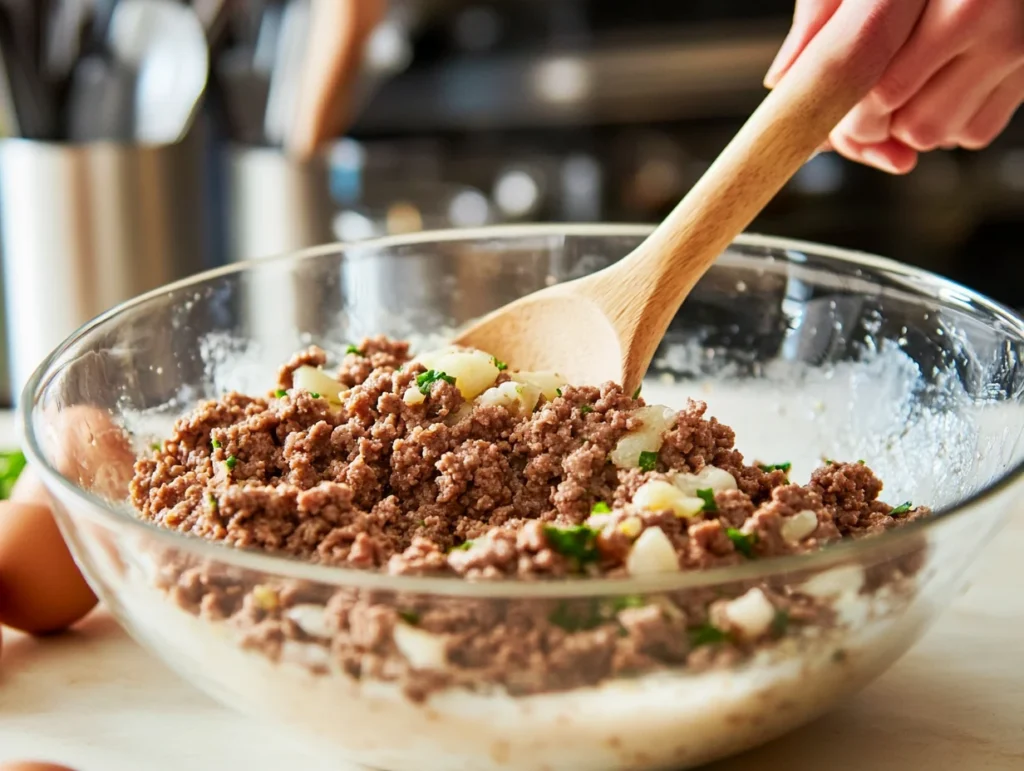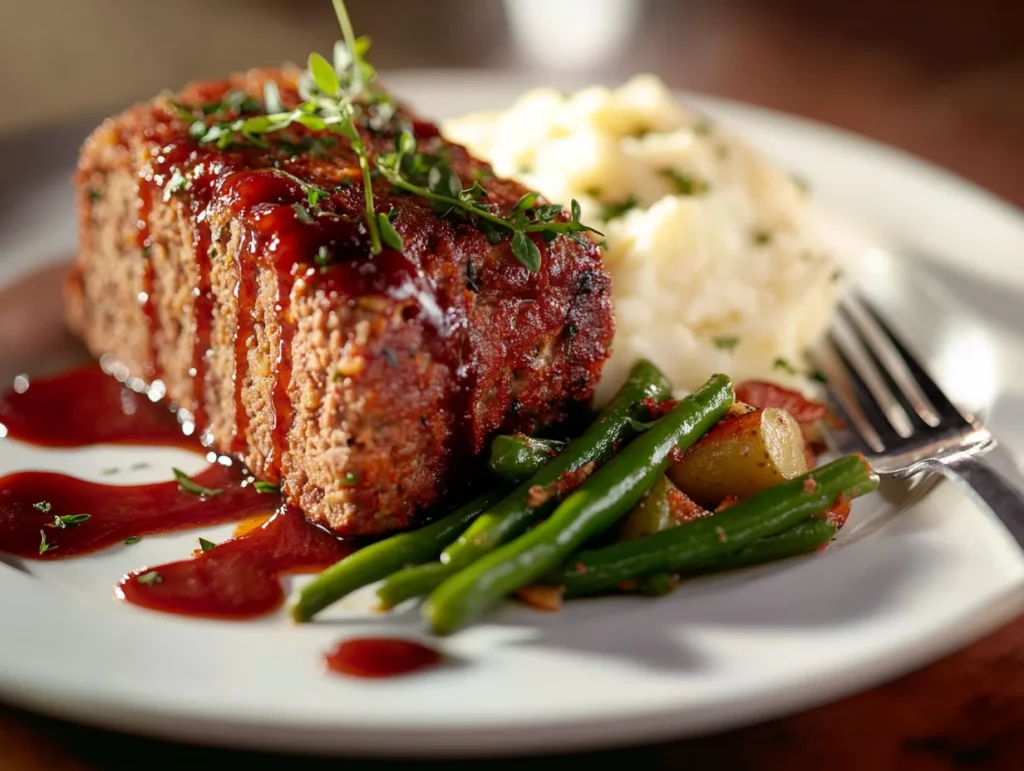Meatloaf is a classic dish that brings comfort and satisfaction to any meal. Yet, many home cooks struggle with one key question: What is the secret to juicy meatloaf? Achieving the perfect balance of moisture and flavor requires not only high-quality ingredients but also a few essential techniques. Whether you’re a beginner or an experienced chef, understanding these secrets will transform your meatloaf into a mouthwatering masterpiece. In this article, we’ll explore everything from ingredient selection to cooking methods, ensuring that your meatloaf turns out moist, tender, and delicious every single time.
Understanding the Basics of Juicy Meatloaf
At its heart, meatloaf is a simple yet versatile dish. However, the difference between a dry, dense loaf and one that’s bursting with flavor lies in the details. To answer the question “What is the secret to juicy meatloaf?”, it’s crucial to focus on three key elements: fat content, binders, and seasonings. While each component plays a unique role, they must work together harmoniously to produce the best results. By carefully balancing these elements, you can achieve a meatloaf that is moist, flavorful, and holds together beautifully.
Selecting the Right Ingredients for Moist Meatloaf
Why a Ground Beef and Pork Mix Is Key to Juicy Meatloaf
One of the most important aspects of answering “What is the secret to juicy meatloaf?” is selecting the right type of meat. While ground beef alone can work, combining it with ground pork significantly enhances the texture and flavor. Beef provides a hearty base, while pork adds natural fat that keeps the meatloaf moist. Ideally, you should use a blend with an 80/20 fat ratio. If you use only lean meat, the lack of fat can lead to a dry and crumbly texture. Additionally, incorporating ground veal into the mix can further elevate the tenderness and flavor of your meatloaf.
Breadcrumbs and Milk: The Secret to Moist Meatloaf
Equally important to the meat selection is the inclusion of breadcrumbs and milk. This combination, known as a panade, is a critical step in achieving a tender texture. Breadcrumbs soaked in milk absorb liquid and release it during cooking, preventing the meatloaf from becoming dense or dry. For the best results, use fresh breadcrumbs or panko for a lighter texture. Simply combine one cup of breadcrumbs with ¾ cup of milk and let it sit for five minutes. This small yet impactful step creates a noticeable difference in the final dish.
Foolproof Tips to Avoid Dry Meatloaf
To ensure a moist and tender meatloaf, it’s vital to avoid common pitfalls. For example, overmixing the meat mixture is a frequent mistake that can result in a tough and dense texture. Gently folding the ingredients until just combined will keep the texture light and airy. Additionally, eggs play an essential role as a binder. They help the meatloaf hold its shape while adding richness and moisture. A good rule of thumb is to use one egg per pound of meat. Lastly, incorporating flavorful ingredients like Worcestershire sauce, garlic, parsley, and thyme not only enhances the taste but also contributes to the overall juiciness of the dish.
For more detailed tips, don’t miss our article: Discover the Secret to a Perfectly Moist Meatloaf.
Step-by-Step Recipe: What Is the Secret to Juicy Meatloaf?
Ingredients
- 1 lb ground beef
- 1 lb ground pork
- 1 cup breadcrumbs
- ¾ cup milk
- 2 large eggs
- 1 small onion, finely diced
- 2 garlic cloves, minced
- 2 tbsp Worcestershire sauce
- 1 tsp salt
- ½ tsp black pepper
- ½ cup ketchup (for glaze)
- 2 tbsp brown sugar
- 1 tbsp Dijon mustard

Instructions
- Preheat the Oven: To start, preheat your oven to 350°F. This temperature ensures even cooking and helps retain moisture.
- Prepare the Panade: In a small bowl, combine the breadcrumbs and milk. Let the mixture rest for about five minutes so the breadcrumbs fully absorb the liquid.
- Mix the Ingredients: In a large mixing bowl, combine the ground beef, ground pork, soaked breadcrumbs, eggs, onion, garlic, Worcestershire sauce, salt, and pepper. Be careful not to overmix; instead, gently fold the ingredients together until just combined.
- Shape the Meatloaf: Form the mixture into a loaf shape and place it on a baking sheet lined with parchment paper. While you can use a loaf pan, shaping the meatloaf by hand allows for better browning and caramelization.
- Prepare the Glaze: In a small bowl, mix the ketchup, brown sugar, and Dijon mustard. Spread half of the glaze over the top of the meatloaf before baking.
- Bake the Meatloaf: Bake the meatloaf for 50-60 minutes, or until the internal temperature reaches 160°F. For more safety tips, refer to USDA Guidelines for Safe Meatloaf Cooking Temperatures.
- Apply the Remaining Glaze: During the final 15 minutes of baking, spread the remaining glaze over the meatloaf. This creates a rich, caramelized topping.
- Let It Rest: Once done, remove the meatloaf from the oven and let it rest for 10-15 minutes. This step allows the juices to redistribute, making each slice moist and tender.
Perfecting the Juicy Meatloaf Glaze
The glaze is the finishing touch that transforms an ordinary meatloaf into a showstopper. While ketchup is a classic choice, you can experiment with other ingredients for added flavor. For example, mixing ketchup with brown sugar and a dash of balsamic vinegar creates a tangy, sweet glaze. Alternatively, BBQ sauce provides a smoky depth of flavor. No matter what you choose, applying the glaze in layers ensures it adheres well and enhances the overall taste.
Cooking Methods to Keep Meatloaf Moist
Baking Sheet or Loaf Pan: Which Is Better for Moist Meatloaf?
The cooking vessel you choose can significantly impact the texture of your meatloaf. A baking sheet allows for better browning on all sides, giving the meatloaf a flavorful crust. However, a loaf pan retains more juices, resulting in a slightly moister interior. For the best of both worlds, shape the meatloaf by hand and cook it on a rimmed baking sheet. This method strikes a balance between moisture and caramelization.
Proper Oven Temperature for Juicy Meatloaf
Cooking your meatloaf at 350°F ensures that it cooks evenly without drying out. If you’re short on time, you can increase the temperature to 375°F but reduce the cooking time accordingly. Always use a meat thermometer to check for doneness, ensuring the internal temperature reaches 160°F.
Adding Vegetables for Extra Moisture

Adding finely chopped or sautéed vegetables to your meatloaf is an excellent way to boost both flavor and moisture. Onions, carrots, celery, and bell peppers are popular choices. By sautéing the vegetables beforehand, you can release their natural sweetness and ensure they’re fully cooked. This step prevents the meatloaf from becoming soggy while enhancing its overall flavor.
The Importance of Resting Meatloaf
Resting your meatloaf after baking is a crucial step that should never be skipped. As the meatloaf rests, the juices redistribute throughout the loaf, ensuring every slice is moist and tender. If you cut into it too soon, the juices will escape, leaving the meatloaf dry. A rest period of 10-15 minutes is ideal and makes all the difference in the final texture.
Common Mistakes to Avoid
To make the best meatloaf, avoid these common mistakes:
- Using lean meat without additional fat, which leads to dryness.
- Overmixing the meat mixture, resulting in a dense texture.
- Skipping the panade, which is essential for moisture.
- Neglecting to rest the meatloaf after baking.
- Adding too much liquid or too many vegetables, causing the meatloaf to fall apart.
Delicious Side Dishes to Pair with Meatloaf
Meatloaf is a versatile dish that pairs well with a variety of side dishes. For a classic combination, serve it with creamy mashed potatoes and steamed green beans. Roasted carrots or Brussels sprouts also make excellent options. If you’re in the mood for something unique, try pairing your meatloaf with cornbread or a tangy coleslaw.
Freezing and Reheating Leftover Meatloaf
Leftover meatloaf is both delicious and convenient, especially when you know what is the secret to juicy meatloaf. To freeze it, wrap individual slices in plastic wrap and place them in an airtight container. When you’re ready to enjoy it, thaw the slices in the refrigerator overnight and reheat them in a 300°F oven. For a crispy exterior, pan-fry the slices in a bit of butter or olive oil.
Customizing Meatloaf for Different Diets
Meatloaf can easily be adapted to fit various dietary needs. For a gluten-free option, replace breadcrumbs with gluten-free panko or almond flour. If you’re following a low-carb diet, crushed pork rinds or grated zucchini make excellent substitutes. For a vegetarian version, use lentils or black beans as a base and flax eggs as a binder.
Creative Twists: Elevating Your Meatloaf Game
If you want to add a creative twist to your meatloaf, consider stuffing it with cheese for a gooey surprise. Alternatively, swap the ketchup glaze for a smoky BBQ sauce or a tangy honey mustard. For a Mediterranean-inspired version, mix in feta cheese, olives, and oregano. These variations keep the dish exciting and flavorful.
FAQs About Juicy Meatloaf
1. Why is my meatloaf dry? Dryness can result from using lean meat, overcooking, or skipping the panade. Always use meat with sufficient fat and avoid overbaking.
2. Can I use turkey instead of beef? Yes, but since turkey is leaner, you’ll need to add extra fat, such as olive oil or grated vegetables, to maintain moisture.
3. How do I achieve a caramelized glaze? To achieve a sticky, caramelized topping, apply the glaze during the last 10-15 minutes of baking at a slightly higher temperature.
4. What’s the best way to freeze meatloaf? Wrap it tightly in plastic wrap and aluminum foil before freezing. It will keep for up to three months.
5. How can I tell when my meatloaf is done? Use a meat thermometer to check that the internal temperature has reached 160°F.

